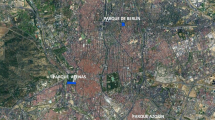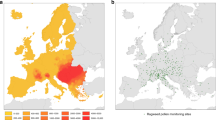Abstract
Iva xanthiifolia Nutt. is an annual species originating from North America that has been first introduced to Europe in the mid nineteenth century. The plant has successfully established mainly in Eastern Europe, where it threatens to become a human health problem because of the allergenic pollen produced by this species. The aim of the study was to reconstruct the colonisation of this species in Eastern Europe and to map its current distribution in Austria based on literature information. In addition, the potential distribution in Austria was assessed using a climate-matching approach. Today, I. xanthiifolia is actively spreading particularly in Hungary, Serbia and Bulgaria. In Austria, the plant occurs only rarely and casually as a ruderal plant mainly in towns, train stations and along railway tracks. Results of a climate matching simulation show that most parts of Austria are outside of the climatic range of I. xanthiifolia. However, the warm and continentally influenced eastern parts of Austria are climatically highly suitable for I. xanthiifolia. Small populations of I. xanthiifolia are already present in this region. In addition, further introductions of I. xanthiifolia in these regions is likely either by natural dispersal from well established population in the neighbouring countries (e.g. Slovakia, Czech Republic), or through contaminated grain imports and bird seed. Because of the potential impact of I. xanthiifolia to human health, establishment and spread of the plant should be monitored and strategies for containment and control should be implemented.

Similar content being viewed by others
References
Adler W, Mrkvicka AC (2003) Die Flora Wiens—gestern und heute. Verlag des Naturhistorischen Museums, Wien
Alien species in Poland (2008) Institute of Nature Conservation PAS. http://www.iop.krakow.pl/ias/ (Zugriff: Oktober 2008)
Baschant R (1955) Ruderalflächen und deren Pflanzen in und um Linz. Naturkundl Jahrb Stadt Linz 1955:253–261
Brandes D (2007) Die Neopyhten der Elbufer im Raum Magdeburg. Braunschweiger Nat kdl Schr 7:821–842
Brennenstuhl G (2007) Bemerkenswerte Arten nach Strassenbaumassnahmen in Salzwedel. Mitt Florist Kart Sachsen-Anhalt 12:95–98
Büscher D (2001) Adventivpflanzen im mittleren und östlichen Ruhrgebiet sowie seiner Umgegend. In: Adventivpflanzen: Beiträge zu Biologie, Vorkommen und Ausbreitungsdynamik von gebietsfremden Pflanzenarten in Mitteleuropa, Tagungsbericht des Braunschweiger Kolloquiums vom 3. bis 5. November 2000, pp 87–101
DAISIE (2008) Delivering Alien Invasive Species Inventories for Europe. http://www.europe-aliens.org/ (Zugriff: Oktober 2008)
Drabova-Kochjarova J (1990) Synanthropic flora of suburb settlements in Bratislava Petrzalka region and some elements as present and potential sources of pollen allergens. Acta Fac Rerum Nat Univ Comenianae Bot 37:53–63
Essl F, Rabitsch W (2002) Neobiota in Österreich. Umweltbundesamt, Wien
FAOSTAT (2008) Food and Agriculture Organization, Statistics. http://faostat.fao.org/ (Zugriff: Oktober 2008)
Fischer MA, Oswald K, Adler W (2008) Exkursionsflora für Österreich, Liechtenstein und Südtirol. OÖ Landesmuseum, Linz
FloraWeb (2008) Daten und Informationen zu Wildpflanzen und zur Vegetation Deutschlands. http://www.floraweb.de/ (Zugriff: September 2008)
Froebe HA, Oesau A (1969) Zur Soziologie und Propagation von Iva xanthifolia im Stadtgebiet von Mainz. Delcheniana 122:147–157
Hejny S (1958) Iva xanthiifolia Nutt. v ČSR. Acta Fac Rerum Nat Univ Comenianae Bot 2:323–342
Henker H (1983) 5. Beitrag zur Adventivflora Mecklenburgs Futtermittelbegleiter. Bot Rundbr Bez Neubrandenburg 14:45–50
Höck F (1902) Ankömmlinge in der Pflanzenwelt Mitteleuropas während des letzten halben Jahrhunderts. Beih Bot Centralblatt XI(4):261–281
Hodi L (2005) Hungarian habitat, damage, biology and herbicide sensitivity of Iva xanthiifolia (Nutt.). Dissertation, Universität Veszprem/Ungarn, Institut für Pflanzenschutz (Kurzfassung in Englisch)
Hohla M, Kleesadl G, Melzer H (2005) Neues zur Flora der oberösterreichischen Bahnanlagen. Beitr Naturkd Oberösterr 14:147–199
Huber HL, Harsh GF (1932) A summer dermatitis caused by a common weed (Cyclachaena xanthifolia). J Allergy 3:578–582
Hunyadi K, Kazinczi G, Lukacs D (1998) Germination biology and allelopathy of Iva xanthiifolia Nutt. Z Pfl Krank Pfl Schutz Sonderh XVI:209–215
Jäger EJ (1988) Möglichkeiten der Prognose synanthroper Pflanzenausbreitungen. Flora 180:101–131
Jäger S (2000) Ragweed (Ambrosia) sensitisation rates correlate with the amount of inhaled airborne pollen. A 14-year study in Vienna, Austria. Aerobiologia 16:149–153
Jehlik VL (1995) Occurrence of alien expansive plant species at railway junctions of the Czech Republic. Ochr Rostl 31:149–160
Lhotska M, Slavik B (1968) Zur Karpobiologie, Karpologie und Verbreitung der Art Iva xanthiifolia Nutt. in der Tschechoslowakei. Folia Geobot Phytotax 4:415–434
Marisavljević D, Pavlović D, Konstantinović B, Meseldzija M (2006) Testing possibilities for chemical control of Iva xanthifolia in soybean. J Plant Dis Prot Sonderheft XX:727–731
Marisavljević D, Stojanović S, Pavlović D, Dolovac-Pfaf E (2007) Prisustvo I kvantitativna zastupljenost alohtone invazivne korovske vrste Iva xanthifolia Nutt. na teritoriji Vojvodine Acta Herbol 16:105–125
Melzer H (1954) Zur Adventivflora von Steiermark I. Mitt Nat Ver Steiermark 84:103–120
Melzer H (1957) Floristisches aus Niederösterreich und dem Burgenland II. Verh Zool Bot Ges Österreich 97:147–151
Melzer H (1958) Neues zur Flora von Steiermark II. Mitt Nat wiss Ver Steiermark 88:193–198
Melzer H, Barta T (1994) Neues zur Flora von Wien, Niederösterreich und dem Burgenland. Verh Zool Bot Ges Österreich 131:107–118
Melzer H, Barta T (1996) Neues zur Flora des Burgenlandes, von Niederösterreich Wien und Oberösterreich. Linzer biol Beitr 28:863–882
Melzer H, Barta T (2000) Crambe hispanica, der Spanische Meerkohl, ein Neufund für Österreich, und weitere floristische Neuigkeiten aus Wien, Niederösterreich und dem Burgenland. Linzer biol Beitr 32:341–362
Nadtochii IN (2008) Cyclachaena xanthifolia (Nutt.) Fresen. In: Afonin AN, Greene SL, Dzyubenko NI, Frolov AN (eds) Interactive agricultural ecological atlas of Russia and neighboring countries. Economic plants and their diseases, pests and weeds. http://www.agroatlas.ru/en/content/weeds/Cyclachaena_xanthifolia/ (Zugriff: Dezember 2008)
NOBANIS (2008) North European and Baltic Network on Invasive Alien Species. http://www.nobanis.org/ (Zugriff: Oktober 2008)
Pax F (1915) Schlesiens Pflanzenwelt. Eine pflanzengeographische Schilderung der Provinz. Fischer, Jena
Polatschek A (1997) Flora von Nordtirol, Osttirol und Vorarlberg. Bd. 1: Einführung, Farnpflanzen, Nadelhölzer, Samenpflanzen: Aceraceae bis Boraginaceae. Verlag des Tiroler Landesmuseum Ferdinandeum, Innsbruck
Sebald O, Seybold S, Philippi G, Wörz A (1993) Die Farn- und Blütenpflanzen Baden-Württembergs, Band 2, Spezieller Teil (Spermatophyta, Unterklasse Dilleniidae), Hypericaceae bis Primulaceae. Ulmer, Stuttgart
Slonovschi V, Zbant M, Vacariv E, Zbant L (1997) Research on useful and damaging flora and its dynamics in the fields of the Podu-Iloaiei agricultural research station. Cerc Agron Moldova 30:259–280
Sluschny H (1980) Bemerkenswerte Adventivpflanzenfunde aus Schwerin und Umgebung. Bot Rundbr Bez Neubrandenburg 11:60–66
Stace CA, Thompson H (1997) New flora of the British Isles. Cambridge University Press, Cambridge
Stieglitz W (1981) Die Adventivflora des Neusser Hafens in den Jahren 1979 und 1980. Gött Flor Rundbr 15:45–51
Sudnik-Wojcikowska B (1987) Iva xanthiifolia Nutt. and its communities within Warsaw. Acta Soc Bot Pol 56:155–167
Sutherst RW, Maywald GF, Kriticos DJ (2007) CLIMEX Version 3: User’s Guide. Hearne Scientific Software Pty Ltd
Święs F (1993) Expansion of Iva xanthiifolia Nutt. in the city of Lublin. Ann. Ann Univ MCS sec C 47:105–126
Święs F, Soroka M (1998) Expansion of Iva xanthiifolia Nutt. in the city of Lvov. Ann Univ MCS sec C 53:93–110
USDA (1971) Common weeds of the United States. Dover, New York
Valkova M, Maneva S (2008) Interactions between Iva xanthiifolia (Nutt.) and other weed species. Herbologia 9:11–19
Virtual Herbaria (2008) Herbarium WU Institute of Botany, University of Vienna. http://herbarium.univie.ac.at/database/ (Zugriff: September 2008)
Wagenitz G (1979) Compositae l: Allgemeiner Teil, Eupatorium—Achillea. In: Hegi G (Begr), Conert HJ, Hamann U, Schultzemotel W, Wagenitz G (Hrsg) Illustrierte Flora von Mitteleuropa, Bd. VI/3, pp 217–218
Weber RW (2002) Burweed marshelder. Ann Allergy Asthma Immunol 89:A6
Weber E, Gut D (2005) A survey of weeds that are increasingly spreading in Europe. Agron Sustain Dev 25:109–121
Weryszko-Chmielewska E, Piotrowska K, Czerneckyj M (2003) Pylek ambrozji (Ambrosia) I iwy (Iva) w powietrzu Lublina I Lwowa. Ann Univ MCS sec EEE Hortic 13:341–349
Williamson M (1996) Biological invasions. Chapman & Hall, London
Wittmann H, Siebenbrunner A, Pilsl P, Heiselmayr P (1987) Verbreitungsatlas der Salzburger Gefässpflanzen. Sauteria 2
Wodehouse RP (1971) Hayfever plants, their appearance, distribution, time of flowering, and their role in hayfever: with special reference to North America. Chronica Botanica Company, Waltham
Wölfel U (2001) Zur Flora von Bitterfeld und Umgebung (8. Beitrag). Mitt Florist Kart Sachsen-Anhalt 6:31–34
ZOBODAT(2008) Zoologisch-Botanische Datenbank, Oberösterreichische Landesmuseen/Biologiezentrum. http://www.zobodat.at/ (Zugriff: Dezember 2008)
Acknowledgemends
Dank gilt Gudrun Strauss (AGES, Fachgebiet gartenbauliche Entomologie) für die Hilfe bei der CLIMEX-Modellierung und Michael Schwarz (AGES, Fachbereich Daten, Statistik und Risikobewertung) für die Erstellung der Karte. Für wertvolle und konstruktive Kommentare danke ich Sonja Wipf und zwei anonymen Gutachtern.
Author information
Authors and Affiliations
Corresponding author
Additional information
Responsible Editor: Sonja Wipf.
Rights and permissions
About this article
Cite this article
Follak, S. Vorkommen und potenzielle Verbreitung des Rispenkrauts (Iva xanthiifolia) in Österreich. Bot. Helv. 119, 7–12 (2009). https://doi.org/10.1007/s00035-009-0051-7
Received:
Accepted:
Published:
Issue Date:
DOI: https://doi.org/10.1007/s00035-009-0051-7




